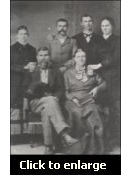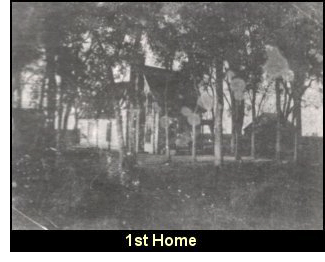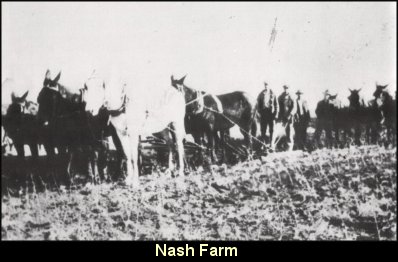
Nash
Compiled by Jean Caddel
Onion and Little Onion, about eight miles southeast of Waxahachie, is a rich and beautiful valley. At the crossroads of FM Road 55 and Nash-Howard Road, in the center of a two by eight mile valley, is the community of Nash. In the early days, it was thought to be unsurpassed in fertility and productiveness by any section in the state, and the excellent soil and crops caused it to receive the name of Garden Valley. The town was named for County Attorney, N. J. Nash. A store was opened in the fall of 1882 by Benjamin Reid. A post office operated from 1883 to 1903. Postmasters were Benjamin Reed, July 12, 1883; Lewis Cole, Jan. 12, 1887; James R. Satterfield, Dec. 21, 1887; Tyra O. Cheatham, Jan. 16, 1895; John W. Miles, April 1, 1898; George W. Wakeland, May 2, 1901; Thomas R. Moore, Dec. 1, 1901; E. Smith, Feb. 24, 1903; discontinued June 30, 1903 and mail sent to Waxahachie.
At one time there were several business houses, a gin, a good school, and churches. About one mile southwest of Nash are two fine wells or springs of water which furnished water for Nash for years. The country around the town is prairie, and there is a considerable quantity of timber along the creeks with shade trees of natural growth. Many years it is green throughout the winter months with the wild rye and winter grasses that grow so abundantly all around the county. About one half mile west of Nash on Forreston Road, you will find Glenwood Cemetery where many of the early pioneers of Nash are buried
Physicians who practiced at Nash and vicinity were: Drs. Bob Satterfield, Stokes, van Clieve, L. S. Nelson and Tate Miller.
 The
Nash school was established around 1875. Pioneer settler
Thomas Alexander Williams brought his family to the Garden
Valley area in 1873. He wanted an education for his children
so he donated land in 1875 for a school building. The first
building burned in 1913, and the current building was erected.
There were only three teachers, but the school holds fond
memories for Nash residents of yesterday. In 1938, the school
doors closed and students were transferred to nearby school
districts.
The
Nash school was established around 1875. Pioneer settler
Thomas Alexander Williams brought his family to the Garden
Valley area in 1873. He wanted an education for his children
so he donated land in 1875 for a school building. The first
building burned in 1913, and the current building was erected.
There were only three teachers, but the school holds fond
memories for Nash residents of yesterday. In 1938, the school
doors closed and students were transferred to nearby school
districts.

Ladies of the community held quiltings. The Wakeland home was right across the road from the school. Maurine Wakeland, wife of "Jew" Wakeland, told of the Nash ladies holding an all-day quilting for them just before they married. "I came down from Fort Worth for the day and they insisted that I work on one of 'our quilts.' It didn't take long for one of the ladies to suggest that I help set the tables for lunch. How was I to know that the stitches were supposed to be small and close together - I had never even seen a quilting frame! I thought all bed covers came from a department store!"
 America
was at war in 1942 and fathers were called into service.
President Roosevelt asked communities to plan entertainment at
home since gasoline rationing had rendered the country almost
immobile as far as travel was concerned. Walter Love, known as
General Love, was County Agent. He suggested that a family
club be organized and named the Nash Victory Club. The ladies
served a bounteous meal to those charter members, and a vow
was made to keep the club going, no matter how hard times
were. For 44 years, people gathered each third Tuesday night
of the month, except for the two hottest months - July and
August. Cold winter nights did not deter the members, since a
large pot-bellied stove and two space heaters kept the old
building cozy and warm.
America
was at war in 1942 and fathers were called into service.
President Roosevelt asked communities to plan entertainment at
home since gasoline rationing had rendered the country almost
immobile as far as travel was concerned. Walter Love, known as
General Love, was County Agent. He suggested that a family
club be organized and named the Nash Victory Club. The ladies
served a bounteous meal to those charter members, and a vow
was made to keep the club going, no matter how hard times
were. For 44 years, people gathered each third Tuesday night
of the month, except for the two hottest months - July and
August. Cold winter nights did not deter the members, since a
large pot-bellied stove and two space heaters kept the old
building cozy and warm.
In 1986 the officers were: Allene Herrington, president; Roland Spence, vice president; Hazel Feaster, secretary/treasurer; W. A. and Mary Alyce Jenkins, building rental committee and Maurine Wakeland, reporter. The club continued to attract new families as they moved out from the cities to the peace and quiet of the lovely countryside. Each Christmas, Santa Claus landed his reindeer on the roof and found his way into the high-ceilinged center room, graced by a large, gaily decorated Christmas tree. He called the children by name and distributed the gifts. Everyone was always welcome at this historical, nostalgic old building.
On Nov. 18, 1980, A Texas State Historical Marker was dedicated for the Nash Public School. Tom Curlin was introduced by Club President Gordon Matteson and there were two people present who had been students of the school over seven decades ago - Mrs. L. L. Curlin and W. J. "Bud" Lanier. Both were 92 years old at the time.
Many descendants still live in the area or nearby communities including the Edmundsons, who are descended from the Wakeland family. Another well known person (living in California) who has ties to this community, is Tippi Pyle, wife of Denver Pyle.
The group continues to meet each month in the old school house and anyone who has an interest in the Nash Community is welcome.

References:
A Memorial and Biographical
History of Ellis County, Lewis Pub. Co. Chicago. 1892
"Nash School Has Rich Heritage", Waxahachie Daily Light -
June 6, 1986
"Preserving the Nash School," by Maurine Wakeland, Waxahachie
Daily Light - date unknown.
The Handbook of Texas Online
Hawkins, et al, History Workshop, History of Ellis
County,Texas, Texian Press, Waco, Tex. 1972.
Glenwood Cemetery Inventory
[In addition to Jean Caddel's history of this community, the following information has been contributed by Collier Nash Smith]
"History of Nash
Community Goes Back
to Last of 19th Century"
[Taken from a typed transcription of an article published in the Waxahachie Daily Light ca 1987 - photocopy obtained from the Ellis County Museum in Waxahachie]
The history of the
Nash Community goes back to the last quarter of the 19th
century. In 1875, pioneer settler Thomas Alexander Williams
brought his family to the area and decided, immediately, that
a school was needed for the children of the little community
that was then known as Garden Valley.
Williams donated the land, and soon a spacious two-story
school building stood ready for the children. The staff of
teachers provided excellent instruction. The school was so
outstanding that it is said families from surrounding areas
brought their children to be boarding students for the length
of the school term. Some "old-timers" recall that even law and
medicine were taught.
In 1883, the community got a post office. There was another Garden Valley in the state, so the name was changed to Nash, the name of the first postmaster. [The Nash cited as "postmaster" cannot be confirmed; other sources don't list him and post office records do not show any postmaster named Nash in Ellis County nor is there any postmaster named N. J. Nash or Newton Nash or John Nash anywhere in Texas. <http://sites.rootsweb.com/~txpost/ellis.html>]
The present Nash School Building is not the original building, but the impact of the community's spirit and its people is just as strong today as it was over 100 years ago!
The Nash Victory Club [is] in its 45th year. The history of the club goes back to 1942 when President Franklin Delano Roosevelt asked the American people to plan "stay-at-home" recreational activities that would develop strong community spirit. The need was great. Morale was at a low ebb all over America, a nation at war! Gasoline was rationed, making an almost "immobile society."
General Walter Love, Ellis County Extension agent, met with some of the leaders of the Nash Community in early November, 1942. It was decided that a monthly basket supper would be held in the Nash School Building. The club was named the Nash Victory Club.
Enthusiasm ran high and that Christmas, the December committee brought in a large Christmas tree that was set up in the center of the stage. Strings of popcorn and homemade ornaments danced among the twinkling lights. The ladies of Nash loaded the serving tables with food. Odds and ends of dishes from various homes have been donated to the club.
A jolly Santa Claus arrived soon after the meal was finished, and eager little children crowded around him to receive their gifts. Later, the children helped to pass out gifts which had been numbered to the adults.
Christmas carols were sung, prayers were offered for the men away at war and the evening ended with the singing of "Silent Night." [end of article]
Notes: The Nash community appears on the Waxahachie Chamber of Commerce map (c) 1996, about 9 mi. south of the courthouse in Waxahachie on FM 55 at the Holder Rd/Nash-Howard Rd intersections. When I drove there in Sept. 1997, it consisted of a Masonic Hall in disrepair and abandoned in appearance, a half-dozen occupied homes, and an old school building being restored as a community center and museum (according to the gentleman living across the road from it, whose name, sadly, I didn't get during the conversation in his front yard). Nash sits among extensive cotton fields on all sides. The 69-year-old gentleman I spoke with said he had lived there all his life, and Nash had 13 saloons, plus several stores and other establishments, when he was a youth. He pointed out the location (a brushy-looking area about 100-200 yards away) where the main street had been, but there is now no trace of street or buildings that I could see from the highway. It is private land, of course, and I didn't have the time to explore further.
Newton John Nash (b. 31 May 1850, Chickasaw Co. Miss.; d. 21 Oct. 1881), the county attorney from 1879 to 1881 when he died at age 31 of a stroke, was my great-grandfather, hence my interest in the area and the community which was probably named for him. He was, despite his youth, the mayor of Waxahachie prior to this (1874-79) but I have found no record nor any family lore naming him as a postmaster.
Copyright © 2002-2019, Ellis County TXGenWeb. All Rights Reserved.
This page was last modified: Thursday, 01-Jul-2021 13:17:16 MDT